What Chemicals Do I Put in When Im Starting My Aquarium Back Up Again
You bought your new aquarium, filled it with water. The next step is adding fish, right?
Agree up!
If y'all add your fish now, they volition soon be expressionless.
Seriously.
Earlier y'all add together any fish to your aquarium, at that place is one important thing you must do:
Cycle it!
To beginners, the nitrogen bike is considered the most confusing part about owning an aquarium.
Simply don't worry – it doesn't have to exist this way.
I am going to show you how to cycle your aquarium the right fashion, with fishless cycling – it'southward much easier than it looks.
What is the nitrogen bike and why is it and so important?
You may take heard the terms biological bike, nitrification process or break-in cycle. Don't get dislocated, these all refer to the same matter I comprehend in this guide – the nitrogen cycle.
Before I show y'all how to perform a cycle, it'due south important that y'all know what is going on behind the scenes.
Imagine swimming in a puddle surrounded past your own pee and poop.
Sounds horrible, right?
Your fish feel the same.
Unfortunately, there is no such thing as a toilet for fish. So, your fish volition poop and pee in the same water they swim in. That'south like yous pooping in your bedroom!
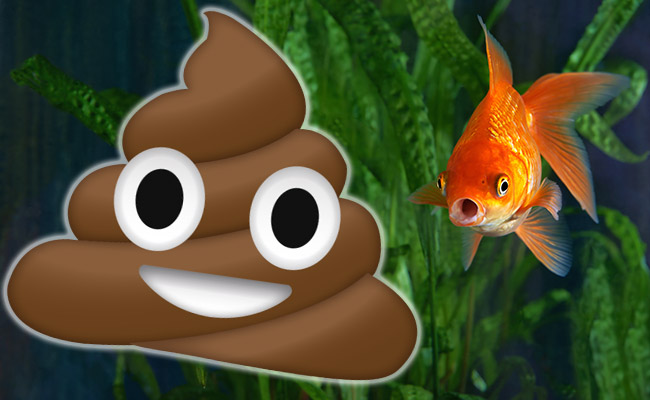
As your fish'southward pee, poop and other waste breaks downward, it releases ammonia into the water. Ammonia is a toxic substance that will impale your fish. Decease by poop? No thank you!
Luckily, nature is on your side. The nitrogen cycle prevents your fish from meeting this horrible end.
In this natural three-phase process, you encourage beneficial bacteria (good bacteria) to go established in your tank and filter, keeping your fish safety from ammonia.
Let's have a closer look at the nitrogen cycle…
The nitrogen cycle procedure
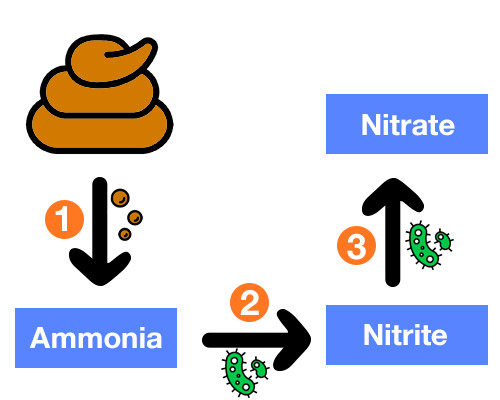
Run across this diagram? This is the nitrogen cycle in a nutshell. Let's break information technology down.
Stage ane: Ammonia (Harmful)
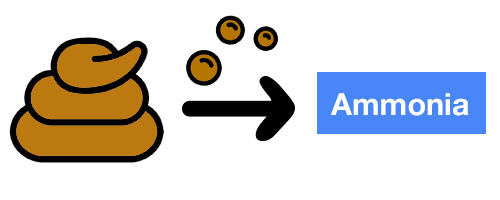
It begins with waste. Poop, pee, uneaten fish nutrient and rotting plants all requite off ammonia as they intermission down.
Ammonia volition continue to build up in your tank, reaching deadly levels. That is, until a beneficial bacteria that eats it begins to form. These bacteria naturally appear in your tank on their own and one time they abound in number, they can swallow ammonia every bit quickly as it appears.
Yous know these bacteria are present in your aquarium when your ammonia levels brainstorm to pass up, typically subsequently the kickoff week. And when that happens, yous know that you are entering the 2nd stage of the nitrogen cycle…
Stage two: Nitrites (Harmful)
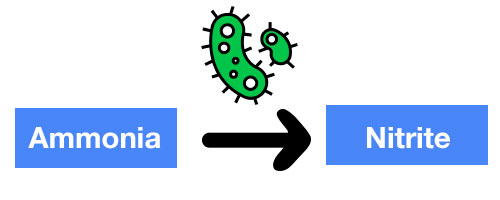
As your ammonia levels begin to decline, you notice that the nitrite levels brainstorm to rising. This is because the leaner that eat the ammonia requite off a new chemical – nitrite.[1]
Merely like ammonia, nitrites are highly toxic to your fish.
But not to worry because every bit your nitrite levels rise, a second leaner appears in your aquarium. It'due south favorite food? Nitrites
In one case this good bacteria grows in number, it tin eat nitrites as quickly as they are produced.
You know this bacteria is present in your aquarium when you see your nitrite levels begin to fall. When this happens, you accept entered the final stage of the nitrogen bicycle.
Stage 3: Nitrates (Harmless)
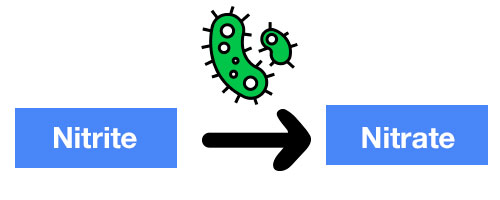
Every bit your nitrite levels refuse, you notice that the nitrate levels rise. This is considering the bacteria that swallow nitrites give off a new chemical – nitrate.[2]
Nitrates are the terminal production of the nitrogen cycle. And, they are relatively harmless to your aquarium, at least in small amounts.
Simply as nitrates build upward, they can become toxic to your fish. Fortunately, nitrates can be lowered back to harmless levels by performing a water change. In fact, this is ane of the reasons why you should be performing regular h2o changes on your aquarium.
Of import: With just a single letter separating nitrites and nitrates, information technology's like shooting fish in a barrel to confuse the two. Remember… Nitrites are highly toxic to your fish while nitrates are not harmful in pocket-size amounts.
And, that's really all there is to the nitrogen cycle!
That wasn't then difficult, was it?
When you cycle your aquarium, you are simply forcing your tank to undergo the nitrogen cycle.
The reason you need to cycle your aquarium is so that these two beneficial bacteria tin can abound to the point that they can consume the harmful ammonia and nitrites as quickly equally they produced.
FishLab Fact: The bacteria that convert ammonia to nitrites and nitrites to nitrates are called nitrifying leaner.
At this signal, you lot tin can consider your aquarium effectively cycled.
It'due south important to understand that the nitrogen bike is continuous. While you lot can't encounter it, this wheel is constantly happening in your aquarium, keeping your fish safety from harm.
What happens if you don't cycle your aquarium?
The nitrogen cycle is a funny affair in that it'due south going to happen whether you want it to or not.
If you lot add your fish to an uncycled aquarium, the nutrient and poop breaking downwards is going to innovate ammonia, which kick-starts the cycling process.
In fact, this is the very idea behind fish-in cycling – a method of cycling an aquarium that is best left to the experts.
But i problem…
You see, your fish are in the tank while toxic ammonia and nitrite levels rising. To say these things are dangerous to your fish is an understatement.
This toxic environment is incredibly harsh on your fish – most fish cannot survive this cycle, and the ones that exercise are more susceptible to disease and don't live as long.
So while a tank may cycle itself without whatever try on your part, there is no guarantee that your make new fish will survive it.
Unfortunately, if you take already bought fish to get with your new tank, a fish-in bike maybe your just option.
If you are in this unfortunate position, don't panic. I created a fish-in cycling guide that will give your fish the best chance of survival.
How long does it have to cycle your aquarium?
The other day I was stocking up on supplies at a major pet store. In the next aisle, I overheard a conversation between an employee and shopper who wanted to buy a pet fish.
I won't diameter you lot with the details, but the employee was working hard to pitch this shopper a new tank – challenge that modern tanks only take ane twenty-four hour period to cycle. Later this 24-hour period, it'due south rubber for fish.
Those of you with a bit of experience volition see correct through this lie.
But for those of you who are new to the hobby, cycling your aquarium is going to have a lot longer than that!
How long?
Depending on who you ask, cycling your aquarium can take anywhere from 2 weeks to 2 months.
The all-time reply:
Information technology volition exist finished when information technology's finished.
If you lot are lucky, your cycle might be brusque. But don't be upset if it takes longer – nosotros've all been there before and information technology sucks!
The problem is that the leaner you lot innovate in the cycle grow very slowly. And all you tin can do is wait.
It is for this reason that you should cycle your aquarium before you lot buy your fish. Don't add them to your aquarium before it has cycled.
Remember… Cycling isn't an instant process. But you have to practice it if you are planning on keeping happy and healthy fish.
Merely don't stress – I'll cover some tricks that you lot can use to speed up the cycling timeline after in this guide.
If you do not accept the patience to cycle your aquarium, then fish are not the right pet for you.
How to cycle your aquarium the easy way
There are two means to cycle your aquarium:
Fishless cycle – A beginner-friendly and harmless method to cycle your aquarium
Fish-in cycling – Recommended merely for experts considering this method could potentially kill your fish
As you probably guessed, this guide covers cycling a tank without risking the lives of fish. And, it is the nigh pop and common technique used to cycle aquariums.
Note: There are many means to perform a fishless bike. This beginner-friendly method, if followed step-by-step, is almost foolproof.
What do you need to perform a fishless cycle?
When information technology comes to cycling your aquarium, you lot only demand 3 products…
1. An aquarium test kit
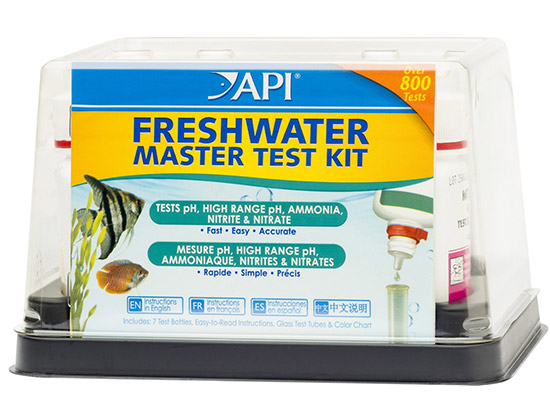
The nitrogen cycle is an invisible process. The only way to truly understand what is happening inside your tank is to examination for it. And, the well-nigh popular way to practice that is with an aquarium examination kit.
I recommend buying a main test kit like the one in a higher place considering information technology contains every test that you need to bicycle your aquarium at ane low cost.
Larn how a test kit works. Check out FishLab'south aquarium test kit guide.
2. Ammonia
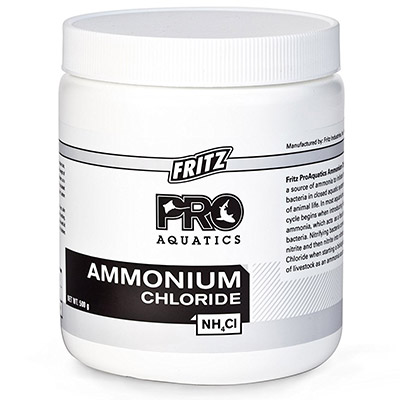
Instead of waiting for waste to break downward into ammonia, add it directly. This will brand it easier to go on ammonia levels constant.
Important: Use 100% pure ammonia. Many household ammonias incorporate scents and additives, and this is going to kill your cycle before you lot even start. Stick to pure ammonia, like the ane to a higher place.
three. Dechlorinator
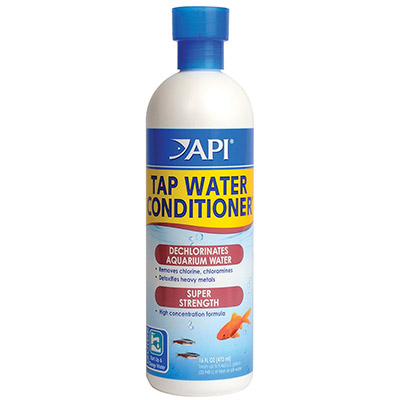
Are you using tap water to fill your aquarium? Be aware that it contains chloramine and chlorine, two chemicals that kill beneficial leaner in your tank.
Fright non! Adding a skillful water conditioner to your aquarium will dechlorinate your h2o, making information technology safe for the beneficial leaner (and fish when you finally add together them).
Use this whenever you add tap water to your aquarium.
Have these on hand? Good. You are now going to learn how to cycle your aquarium in six simple steps.
FishLab'southward 6-step bike method
Cycling your aquarium is like shooting fish in a barrel…
Every bit long as you advisedly follow the instructions!
And then, slow down and make sure you lot understand each step before moving to the adjacent. If you don't, you risk ruining the bicycle. And if that happens, you will accept to offset over.
Step 1. Set upward your aquarium
Y'all know all that equipment y'all got with your aquarium? Well, you lot need to ready all that up.
Heater, filter, air pump, substrate, plants… Go information technology in in that location.
Why do you need your tank fully set upward?
Well, beneficial bacteria needs a surface to cling to, namely your substrate and filter media. In fact, near of the bacteria will call your filter home.
Once your tank is prepare, you want to go along whatsoever electrical equipment, such as heaters, bubblers and filters, switched on throughout the cycling process. Doing so encourages the benign leaner to grow and may even make your tank bicycle faster.
Note: Beneficial bacterial prefer temperature between 65-85 degrees Fahrenheit. Growth is slower outside of this temperature range – which can cause your bike to take longer to complete. Check your h2o temperature with an accurate aquarium thermometer.
Step 1 Summary
- Fix up your aquarium
- Turn on all electrical equipment
Step 2: Check your pH
This is perhaps ane of the nigh commonly missed steps when it comes to cycling your tank – and a common cause of failed cycles.
You see, the cycling process can slow down or fifty-fifty stop if the pH level of your water drops below 7.
Since the principal examination kit includes a pH test, it would be empty-headed not to use information technology at present.
So, check the water y'all added to your aquarium with your test kit. If information technology's below 7, you demand to enhance your pH before moving to the next step.
Good news! This won't be a trouble for virtually of y'all considering the majority of h2o supplies beyond the The states test at a pH that is greater than seven.
Even so, you want to continue performing pH tests throughout the cycling process. You lot run into, the benign bacteria in your tank requite off acids that lower the water pH over time.
If yous notice that your pH levels drop under 7, a simple 20% h2o modify is all that's needed to raise the pH and go the wheel going once more.
So, make certain you lot test your pH regularly and adjust it if needed.
Step 2 Summary
- Test the pH of your water
- Adjust when lower than vii pH
Step 3: Add together your ammonia
In a brand new tank, there won't exist any waste material, pregnant nothing to break down into ammonia. So, we must add together information technology ourselves.
Merely take your Fritz Ammonia and read the instructions.
At the time of writing this, one level teaspoon of Fritz Ammonia per 100 gallons of h2o will give yous an ammonia level of four parts per one thousand thousand (ppm).
You demand to know how much h2o is in your aquarium in order to add together the correct amount of ammonia. Use FishLab's gallon calculator if y'all are unsure of just how much water your tank holds.
So, mensurate out your ammonia…
Fish tanks less than 40 gallons: Aim for 2 ppm
Fish tanks more than 40 gallons: Aim for 4 ppm
While y'all tin can steal the measuring spoons from your kitchen, I recommend having a dedicated fix of measuring tools for your aquarium.
You now want to brand sure that yous accept added the correct amount of ammonia. And to practise this you are going to use your aquarium test kit, which will give you lot a result in ppm
But earlier y'all practice that, you want to let the ammonia sit down for an hour, and so that it evenly distributes throughout the water. Next, measure the ammonia levels using the ammonia test from your primary exam kit – Make certain yous follow the instructions provided by the test kit for accurate results.
If your ammonia readings are less than the above levels, add together more ammonia and re-test.
If your ammonia levels are college, perform a water modify. Doing so will bandy out your loftier-ammonia water with ammonia-free h2o, lowering the levels.
Record the corporeality of ammonia that you added. Yous will demand that information in the rest of the steps.
Ammonia levels higher than 5 ppm can actually slow down the cycling process.
Now, the adjacent office will exam your patience. Check your ammonia levels each day with the exam kit. This is as much as you can exercise for now. You are waiting for your ammonia levels to drop.
This typically takes a week. Once a week has passed, it's time to move onto the side by side step.
Bookmark this page then that you can easily find information technology when you are ready for the next step!
Run into you next calendar week!
Pace 3 Summary
- Add ammonia to your aquarium
- Daily testing to monitor ammonia levels
- Don't forget to test the pH every few days
Step four: The ammonia eating bacteria appears
After a week has passed, information technology's fourth dimension to test for nitrites. And so, grab your nitrite test kit and bank check the levels.
If your test comes dorsum positive, congratulations – your cycle has officially started!
Now, it's important to call back that this leaner feeds on ammonia. And the just matter calculation ammonia to this aquarium is yous. If your ammonia levels achieve zero, this bacteria will starve, and yous will have to start your cycle all once more.
So, we are going to requite this leaner a little more than food. Add half the amount of ammonia that you added on day one, only brand sure that your ammonia levels remain under 5 ppm.
Now what yous want to do is monitor your nitrites, testing daily. You lot should find the nitrite levels continue to ascension. Once you see your nitrite levels start to drop, it'due south time to motility onto the next pace.
See you once more in a few days!
Step four Summary
- In one case nitrites are detected, add a half dose of ammonia
- Ensure ammonia levels are less than 5 ppm (but greater than 0 ppm)
- Daily testing of ammonia and nitrite levels
- Don't forget to test the pH every few days
Stride v: The nitrite eating bacteria appears
To confirm that the nitrite drop is due to the beneficial leaner, utilize your exam kit to cheque for nitrates. If they are present, you are now in the terminal stage of cycling your tank.
Now, we nonetheless desire to make sure that the leaner has enough food to eat. So add a half dose of ammonia as needed, each solar day if you have also, to proceed the levels above 1 ppm.
Go on testing. When you can add a half dose of ammonia and both your ammonia and nitrite levels read goose egg 24 hours later, your nitrogen cycle is complete.
Woo! Domicile stretch… Only 1 more step to make it official!
Pace 5 Summary
- Test to confirm nitrates
- Daily testing of ammonia and nitrite levels
- Add half doses of ammonia every few days
- When both ammonia and nitrites prove <0.2 ppm, bandy to daily dosing
- Test until both ammonia and nitrites read zero 24 hours afterwards dosing
- Don't forget to test the pH every few days
Footstep 6: The Final Test
You are and so close. You but want to make certain that your tank is fully cycled. To do that, one last test is in order…
Once your ammonia and nitrite levels attain nothing, add together a full dose of Fritz Ammonia, the same amount that you added on day 1. Now, will need to await one last time…
Check back in 24 hours. Exam your ammonia and nitrite levels. If both read zero….
Congratulations!
Your patience has paid off, and your tank is now fully cycled.
If you record your examination kit readings each day, y'all will have a articulate understanding of the nitrogen cycle.
This chart is from the last time I cycled my tank:
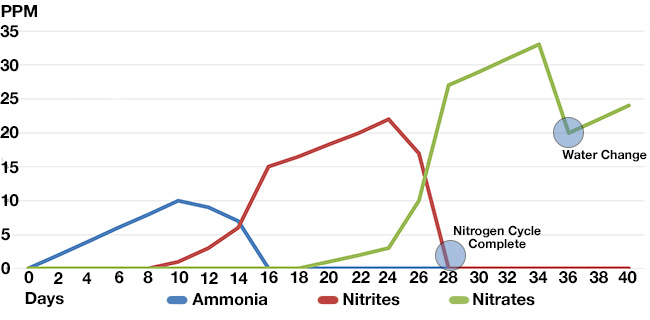
It took me 28 days to wheel the aquarium.
You see a singled-out rise and fall of ammonia and nitrites as the beneficial bacteria become established in the tank. You lot can also see how nitrates drop at each water alter.
I highly recommend recording the results of your test kits each solar day. Not only will it give you a better agreement of what is happening in your tank, just you can also use the results for troubleshooting.
Now that your tank is cycled, the bacteria colonies are large enough to remove ammonia and nitrites as chop-chop as they are produced…This nasty stuff won't be harming your fish anytime shortly!
Only before you lot add your fish, you want to perform a water change to remove those built upwardly nitrates.
Speaking of which… You should add your fish to your tank now. If you don't plan on adding fish just yet, keep dosing the tank with ammonia daily. This volition ensure that the beneficial bacteria don't starve. If the bacteria starve and dye, you are going to have to cycle your fish-tank all once more.
It might have felt similar a lot of effort, only your hard piece of work volition be rewarded once you lot see just how salubrious and happy your fish are. And, it's all cheers to your newly cycled tank!
Determination
Phew, y'all did it! You should be proud of yourself. Your patience has paid off, and your tank is now cycled.
Past cycling your aquarium, you give your fish the best possible take a chance to live a happy and healthy life.
Just retrieve that one time started, the nitrogen wheel consistently runs in the background of your aquarium.
Only you are not home free merely yet.
You even so need to continuously monitor your ammonia and nitrite levels to ensure that something hasn't gone wrong. I recommend that y'all include testing your tank equally part of your maintenance routine.
How did yous cycle your aquarium? Let me know in the comments beneath!
Source: https://fishlab.com/how-to-cycle-aquarium/
0 Response to "What Chemicals Do I Put in When Im Starting My Aquarium Back Up Again"
Post a Comment